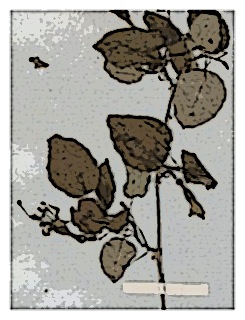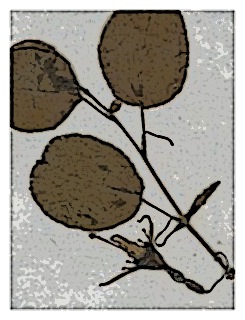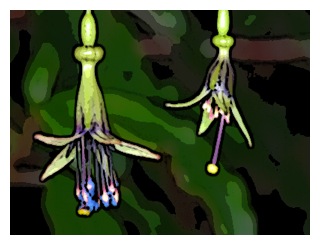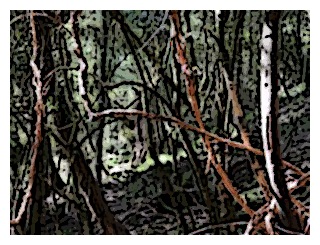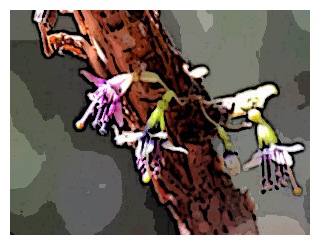
The Genus Fuchsia
Section Skinnera
(three species)
This section consists of three woody species. Two are found throughout New Zealand and one in drier highlands on the island of Tahiti. They form trees or shrubs and one liana all with alternate, opposite or ternate leaves. The solitary, axillary flowers are pendulous or divergent, with a floral tube 6 to 22 mm long and have smooth, band-type nectaries. The sepals are green, later turning red or purple when mature, and the petals are purple. The stamens occur in two unequal series with blue pollen. The seeds number between five and 700, arranged in several rows per locule. F. procumbens, formerly included here, now forms a section of its own in Procumbentes (Goodley & Berry 1995).
This section's name is derived from the Rev. Richard Skinner, an English botanist, who was the rector of Bassingham in Lincolnshire from 1774. He was well known in the botanical circles of his time and a friend of Forster & Forster, who named Skinnera excorticata for him in 1776, as well as of Sir Joseph Banks. Alas for the honor, Skinnera excorticata, a plant actually already collected in New Zealand by Banks & Solander in 1769, was never validly published. It was moved to Fuchsia when Carl Linnaeus the Younger recognized the connection in 1781. The Swiss botanist, Augustin Paramus de Candolle (1778-1841), however, revived Skinnera as the name of one of the then two novel sections into which he divided the genus Fuchsia in 1828. The name is sometimes incorrectly seen as Skinneria. (Godley & Berry 1995).
Name: Fuchsia sect. Skinnera (J.R.Forst. & G.Forst.) DC., 1828.
Typus: F. excorticata L.f.
Synonyms
Basionym
Skinnera J.R.Forst. & G.Forst., Char. Gen. Pl. 29. 1775.
Section Skinnera
(three species)
This section consists of three woody species. Two are found throughout New Zealand and one in drier highlands on the island of Tahiti. They form trees or shrubs and one liana all with alternate, opposite or ternate leaves. The solitary, axillary flowers are pendulous or divergent, with a floral tube 6 to 22 mm long and have smooth, band-type nectaries. The sepals are green, later turning red or purple when mature, and the petals are purple. The stamens occur in two unequal series with blue pollen. The seeds number between five and 700, arranged in several rows per locule. F. procumbens, formerly included here, now forms a section of its own in Procumbentes (Goodley & Berry 1995).
This section's name is derived from the Rev. Richard Skinner, an English botanist, who was the rector of Bassingham in Lincolnshire from 1774. He was well known in the botanical circles of his time and a friend of Forster & Forster, who named Skinnera excorticata for him in 1776, as well as of Sir Joseph Banks. Alas for the honor, Skinnera excorticata, a plant actually already collected in New Zealand by Banks & Solander in 1769, was never validly published. It was moved to Fuchsia when Carl Linnaeus the Younger recognized the connection in 1781. The Swiss botanist, Augustin Paramus de Candolle (1778-1841), however, revived Skinnera as the name of one of the then two novel sections into which he divided the genus Fuchsia in 1828. The name is sometimes incorrectly seen as Skinneria. (Godley & Berry 1995).
Name: Fuchsia sect. Skinnera (J.R.Forst. & G.Forst.) DC., 1828.
Typus: F. excorticata L.f.
Synonyms
Basionym
Skinnera J.R.Forst. & G.Forst., Char. Gen. Pl. 29. 1775.

Tahiti. Endemic to several of the highest peaks on the western (drier) side of the island of Tahiti at elevations from 1,150 to 2,000 meters.
F, cyrtandroides flowers mostly in the dry season, from July to October, but occasionally and less intensively in other months throughout the year.
Habit: Small tree (2 to) 3 to 7 m tall, with numerous ascending branches; trunk with tan-copper, slightly fissured bark, 5 to 30 cm in diameter. Branchlets subglabrous, 4 to 6 mm thick, usually quadrangular.
Leaves: Mostly opposite, occasionally ternate, less commonly alternate or subopposite, subcoriaceous to firm fleshy, (broadly) elliptic or obovate, (2 to) 4 to 12 cm long, (1.5 to) 2 to 6 cm wide, rounded or obtuse at apex, rounded to acute at base, green above, whitish below and sometimes purple-flushed; margin subentire with small, reddish, glandular teeth; midvein raised below, secondary veins (7 to) 8 to 12 on each side. Petioles stout, 1.5 to 3 mm thick when fresh, 5 to 25 (to 35) mm long. Stipules triangular, dark purple, 0.5 to 0.8 mm long, 0.4 to 0.75 mm wide and crassate at the base, caducous.
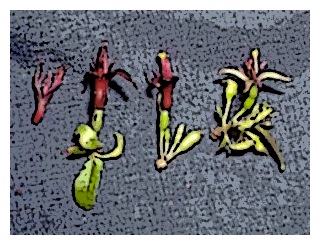
Fruit: The berry is oblong-fusiform or ellipsoid, 9 to 16 mm long, 5 to 10 mm wide, and purple-black and juicy when ripe.
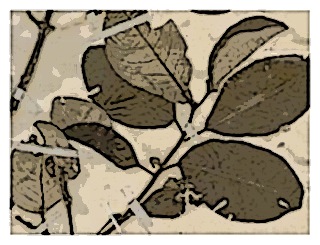
Seeds: The seeds oblong-triangular, 0.9 to 1.2 mm long, 0.4 to 0.7 mm thick, and light brown.
Chromosomes: Gametic chromosome number n = 11.
Authors—Moore 1940.
Original publication—Occas. Pap. Bernice Pauahi Bishop Mus. 16: 13 1940.
Synonyms—None.
Herbarium Specimens—Bishop.
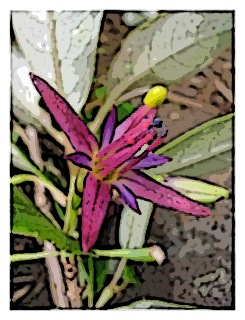
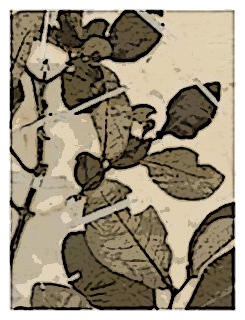
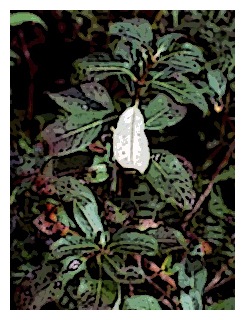
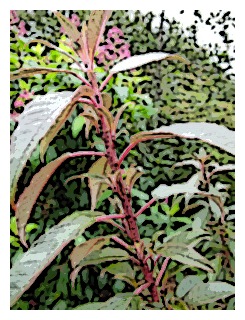
New Zealand. Tree Fuchsia or Kotukutuku (Maori). Widespread all over North Island, South Island, and Stewart Island of New Zealand but rare on Auckland and Chatham Islands, and found in lowland to upper montane forest, especially along margins and near streams, at elevations from sea level to 1,050 meters.
Flowering is mostly from August to December, but occasionally from as early as June or July, and as late as the end of January. The berries are often known by their Maori name, konini.
Habit: Large shrub or tree 2 to 13 m tall, winter deciduous in most of its range; trunk generally irregular, more-or-less twisted, to 70 cm in diameter, branching within several meters of the base to form a broad, spreading canopy; bark coppery light brown and papery, peeling off readily in patches or large strips, with a smooth, green cambial layer beneath the outer layers; branches subglabrous to strigulose.
Leaves: Alternate, thick-membranous, lanceolate to ovate-elliptic, (35 to) 45 to 130 mm long, (15 to) 25 to 55 mm wide, acute to acuminate at apex, acute to rounded at base, strongly bicolored, medium to dark green above,
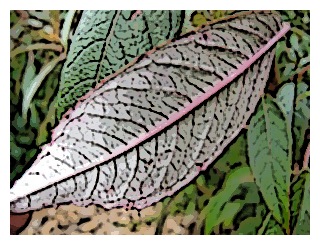
Flowers: Gynodioecious. Perfect flowers, solitary or more-or-less tightly grouped on shortened side shoots, sometimes appearing cauliflorous, pedicels slender, drooping in bud and flower, divergent or ascending in fruit, 5.5 to 15 mm long, ovary 4.5 to 8 mm long, 1.7 to 3 mm thick, green, floral tube 11 to 22 mm long, 3 to 5 mm wide at the bulbous base (lined by smooth nectariferous tissue inside), sharply constricted above to 1.4 to 2.5 mm in diameter, then enlarged until 4 to 10 mm wide at the rim, with four antepetalous ridges, sepals narrow-triangular, 8 to 19 mm long, 3 to 6 mm wide at base, spreading or occasionally reflexed. Tube and sepals lustrous green at anthesis, with dull purple streaks in upper parts between the ridges of the tube, both changing more-or-lee abruptly to red-crimson about halfway through anthesis. Petals, dark purple, (narrowly) elliptic or lanceolate, 1.85 mm long, 0.7 to 2.1 mm wide in the middle, acute or obtuse at apex, filaments 6 to 15 mm and 5 to 10 mm long, light to dark purple, pale cream on connective to anthers. Anthers 1.8 to 2.5 mm long, 1 to 1.7 mm thick, purple, style glabrous, 22 to 40 mm long, purple in exserted part and greenish below, stigma capitate, 1.8 to 2.2 mm long, 1.4 to 2.1 mm wide, yellow-green. Pistillate flowers, similar to perfect ones except: Pedicels 4.5 to 8.5 mm long. Ovary 4 to 6 mm long, 2 to 2.5 mm wide. Floral tube 6.5 to 13 mm long, 4 to 6 mm in diameter at rim. Sepals 5.5 to 8 mm long, 2.2 to 3.5 mm wide at base. Petals 1.2 to 2.6 mm long, 0.35 to 1 mm wide. Filaments 2 to 4 mm and 1.2 to 3.5 mm long. Anthers aborted, 0.8 to 1.2 mm long, 0.6 to 0.9 mm wide. Style 18 to 23 mm long.
Fruit: The berry is oblong-ellipsoid, 9 to 13 mm long, 5 to 8 mm thick, and dark purple.
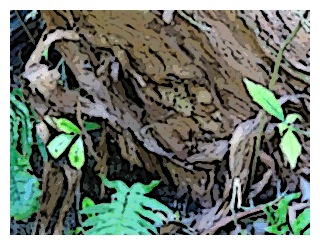
Seeds: Oblong-triangular, 0.75 to 1 mm long, 0.3 to 0.6 mm broad, tan, 320-670, but mostly around 500, per fruit.
Chromosomes: Gametic chromosome number n = 11.
Authors—J. R. & G. Forster 1781.
Original publication—Suppl. Pl. 217 1782.
Synonyms—Skinnera excorticata J. R. & G. Forster.
Herbarium Specimens—Smithsonian 1; Smithsonian 2.
F. perscandens Cockayne & Allan
New Zealand. 0-550 m. Found infrequently in lowland forests especially at margins and near clearings on the North Island as far north as 36°S latitude (from historical data), but now known no farther north than 37°15'S latitude near Paeroa, and throughout the South Island at scattered localities as far south as Bluff (46°36'S), from sea level to 550 meters in elevation.
The flowering season is from August to March.
Habit—Slender and densely branched, usually decumbent shrub one to two meters tall, or liana two to eight meters tall with strongly flexuous stems to 5 cm in diameter and up to ten meters long; bark brown, flaking off in strips; branchlets strigulose.
Leaves—Alternate, firm-membranous, broadly ovate to suborbicular, 7 to 40 mm long, 5 to 33 mm wide, acute to rounded at apex, subcordate to rounded at base, pale green, paler beneath, glabrous to strigulose along the margins and veins; margin remotely serrulate to sinuate; secondary veins 3 to 5 on either side. Petiole slender-filiform, semi-translucent, 10 to 40 mm long, subequal to the blade length, strigulose above, the basal 1 to 1.5 mm swollen and crassate, purple when fresh, tan when dry, generally persistent on the stem after the leaf dehisces. Stipules narrowly triangular, 0.8 to 1.3 mm long, 0.3 to 0.6 mm wide, semisucculent and purple when young, caducous.
Flowers—Gynodioecious. Perfect flowers, solitary, sparse, pedicels slender, drooping, 4.5 to 12.5 mm long, ovary cylindrical, 3 to 7 mm long, 1 to 2.4 mm thick, green, floral tube 9 to 16 mm long, 2.2 to 4 mm wide and bulbous at the base, lined by a smooth nectariferous band inside, sharply constricted above to 1.3 to 2 mm wide, then widening abruptly to 5.5 to 7.5 mm wide at the rim, four-angled in bud, sepals lanceolate, 7 to 12 mm long, 3 to 4.4 mm wide at the base, spreading to occasionally reflexed. Tube and sepals lustrous green at anthesis, with dull purple streaks in upper parts between the ridges of the tube, both changing more-or-less abruptly to red-crimson throughout before dehiscing, petals dark purple, elliptic, 1.5 to 4 mm long, 0.6 to 1 mm wide in the middle, acute or obtuse at apex, filaments 5.2 to 11 mm and 4.2-8 mm long, purple, pale cream on connective, anthers 1.6 to 2.5 mm long, 1 to 1.7 mm wide, purple, style 20 to 36 mm long, pale cream to purple, stigma capitate, 1 to 1.9 mm long, 0.8 to 1.1 mm wide, yellow-green. Pistillate flowers, similar to perfect ones except, pedicels 4 to 16 mm long, floral tube 5.8 to 10.8 mm long, 1.1 to 2.5 mm in diameter at the constriction, 3.5 to 5.3 mm wide at rim, sepals 5.7 to 9 mm long, 2.6 to 3.4 mm wide at base, filaments 2.5 to 5.2 and 1.5 to 4.4 mm long, anthers aborted, 0.7 to 1.1 mm long, 0.5 to 0.7 mm thick, style 16 to 27 mm long, stigma 1 to 2.2 mm thick.
Fruit—The berry is subcylindric, 5 to 9 mm long, 4 to 5.5 mm thick, and dark purple when ripe.
Seeds—The seeds are oblong-triangular, 0.8 to 1.1 mm long, and 0.4 to 0.6 mm wide.
Chromosomes—Gametic chromosome number n = 11.
Authors—Cockayne & Allan 1927.
Original publication—Trans. & Proc. New Zealand Inst. 57: 53 1927.
Synonyms—None.
Herbarium Specimens—
New Zealand. 0-550 m. Found infrequently in lowland forests especially at margins and near clearings on the North Island as far north as 36°S latitude (from historical data), but now known no farther north than 37°15'S latitude near Paeroa, and throughout the South Island at scattered localities as far south as Bluff (46°36'S), from sea level to 550 meters in elevation.
The flowering season is from August to March.
Habit—Slender and densely branched, usually decumbent shrub one to two meters tall, or liana two to eight meters tall with strongly flexuous stems to 5 cm in diameter and up to ten meters long; bark brown, flaking off in strips; branchlets strigulose.
Leaves—Alternate, firm-membranous, broadly ovate to suborbicular, 7 to 40 mm long, 5 to 33 mm wide, acute to rounded at apex, subcordate to rounded at base, pale green, paler beneath, glabrous to strigulose along the margins and veins; margin remotely serrulate to sinuate; secondary veins 3 to 5 on either side. Petiole slender-filiform, semi-translucent, 10 to 40 mm long, subequal to the blade length, strigulose above, the basal 1 to 1.5 mm swollen and crassate, purple when fresh, tan when dry, generally persistent on the stem after the leaf dehisces. Stipules narrowly triangular, 0.8 to 1.3 mm long, 0.3 to 0.6 mm wide, semisucculent and purple when young, caducous.
Flowers—Gynodioecious. Perfect flowers, solitary, sparse, pedicels slender, drooping, 4.5 to 12.5 mm long, ovary cylindrical, 3 to 7 mm long, 1 to 2.4 mm thick, green, floral tube 9 to 16 mm long, 2.2 to 4 mm wide and bulbous at the base, lined by a smooth nectariferous band inside, sharply constricted above to 1.3 to 2 mm wide, then widening abruptly to 5.5 to 7.5 mm wide at the rim, four-angled in bud, sepals lanceolate, 7 to 12 mm long, 3 to 4.4 mm wide at the base, spreading to occasionally reflexed. Tube and sepals lustrous green at anthesis, with dull purple streaks in upper parts between the ridges of the tube, both changing more-or-less abruptly to red-crimson throughout before dehiscing, petals dark purple, elliptic, 1.5 to 4 mm long, 0.6 to 1 mm wide in the middle, acute or obtuse at apex, filaments 5.2 to 11 mm and 4.2-8 mm long, purple, pale cream on connective, anthers 1.6 to 2.5 mm long, 1 to 1.7 mm wide, purple, style 20 to 36 mm long, pale cream to purple, stigma capitate, 1 to 1.9 mm long, 0.8 to 1.1 mm wide, yellow-green. Pistillate flowers, similar to perfect ones except, pedicels 4 to 16 mm long, floral tube 5.8 to 10.8 mm long, 1.1 to 2.5 mm in diameter at the constriction, 3.5 to 5.3 mm wide at rim, sepals 5.7 to 9 mm long, 2.6 to 3.4 mm wide at base, filaments 2.5 to 5.2 and 1.5 to 4.4 mm long, anthers aborted, 0.7 to 1.1 mm long, 0.5 to 0.7 mm thick, style 16 to 27 mm long, stigma 1 to 2.2 mm thick.
Fruit—The berry is subcylindric, 5 to 9 mm long, 4 to 5.5 mm thick, and dark purple when ripe.
Seeds—The seeds are oblong-triangular, 0.8 to 1.1 mm long, and 0.4 to 0.6 mm wide.
Chromosomes—Gametic chromosome number n = 11.
Authors—Cockayne & Allan 1927.
Original publication—Trans. & Proc. New Zealand Inst. 57: 53 1927.
Synonyms—None.
Herbarium Specimens—
F. x colensoi Hook.f.
New Zealand. Widespread from 38 16'S south through the North and South Islands of New Zealand, also Stewart Island from sea level to 300 meters in elevation.
Flowering is mostly from August to January but occasionally earlier on some locations.
This former species is now recognized to be a naturally occurring hybrid between F. excorticata and F. perscandens.
Habit—Small to large shrubs or small tree, the main branches upright, scandent-climbing or decumbent; main stm to 30 cm diameter; bark parry, copper colored, reality flaking off.
Leaves—Alternate, thick membraneous, usually broadly elliptic-ovete, lance -ovate or sub orbicular, 18 to 85 mm long, 10 to 45 mm wide, obtuse to acute at apex, truncate to obtuse to subcordate at base, pale green above, paler to whitish beneath; margin entire to serrate with small glandular teeth; secondary veins (5 to) 6 yo 8 (9) per side. Petiole slender 5 to 50 mm long, subglabrous to strigulose above sometimes with a semi-persistent swollen base. Stipules triangular, 0.8 to 2.4 mm long, 0.4 to 1.1 mm wide, semi succulent and purple when young, quickly during form the tip, caducous.
Flowers—Gynodioecious. The flowers intermediate in size between F. excorticata and F. perscandens. Perfect flowers: Pedicels slender, hanging 5 50 14 mm long. Ovary 4 to 7 mm long, 1.6 6o 2.5 mm thick, green. Floral tube 9 to 20 mm long, 2.5 to 4.2 mm
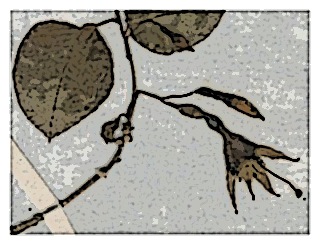
Fruit—The berry is oblong to subglobose, 9 to 11 mm long, 5 to 7 mm wide, and red-purple.

Seeds—Oblong-triangular, 0.8 to 1.1 mm long 0.4 to 0.6 mm wide, and numbering 240 to 500 per fruit.
Chromosomes—Gametic chromosome number n = 11 with no meiotic irregularities observed.
Authors—Hooker 1867.
Original publication—Handb. N. Zeal. Fl. 728 1867.
Synonyms—F. x experscandens Allan 1926.
Herbarium Specimens—Kew 1, Kew 2, Kew 3, Kew 4, Kew 5.
